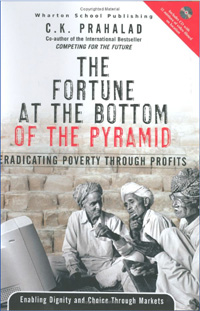
BRINQ is the home of entrepreneur and product designer Patrick Donohue, whose work focuses on high impact startups and products.
 Recently we've received a number of requests for more information on the Base of the Pyramid. One of the best places to start is with the work by C.K. Prahalad and Stuart Hart. Prahalad and Hart were both featured prominently at December's WRI "Eradicating Poverty through Profit" conference in San Francisco, which we along with 900 other representatives of businesses, NGOs, universities, and governments attended.
Recently we've received a number of requests for more information on the Base of the Pyramid. One of the best places to start is with the work by C.K. Prahalad and Stuart Hart. Prahalad and Hart were both featured prominently at December's WRI "Eradicating Poverty through Profit" conference in San Francisco, which we along with 900 other representatives of businesses, NGOs, universities, and governments attended.
Below is an excerpt from an interview with Prahalad about his new book "The Fortune at the Bottom of the Pyramid":
Your book’s subtitle reads “eradicating poverty through profits.” A rather sweeping promise, isn’t it?
Not at all. My book is about a new world economic order in which there is an invisible market constituency of 5 billion people. It is invisible to us because of the way we’ve been socialized to think. If you take the top developing countries—China, India, Brazil, Mexico, Indonesia, Turkey, Russia, South Africa, Thailand, the usual suspects—they represent 70 to 75 percent of the world’s poor population and about 90 percent of the GDP of developing countries. We tend to look at the GDP in U.S. dollar terms, which don’t give you any idea of the nature and intensity of commerce in those countries. You have to look at purchasing- for-parity dollars. If you look at those dollars, it’s about $14 trillion —and that sum is larger than that of Germany, France, Italy, Japan, and the United Kingdom put together.
How can they afford to buy companies’ goods and services?
We always assume: If you have money, I can sell it to you. The more interesting question deals with creating the capacity to consume: How do I sell something to you—commercially, profitably—if you don’t have the money? A very American example of how to do it is the Singer sewing-machine company 150 years ago. Poor people who needed the machines didn’t have the $100 to pay for them, so Singer said, Why don’t you pay in installments of $5 a month? They sold a lot of sewing machines using that scheme. That’s exactly what Casas Bahia, a large retailer of consumer durables, is doing now in Brazil. If I live in one of the favelas—the shantytowns in São Paolo or Rio de Janeiro—I don’t have the $300 that’s required to buy a television. But I can pay $25 a month, and therefore if you trust me and give me credit, then I can pay you back. That means I am saving and consuming simultaneously, If you look at Casas Bahia, or Cemex in Mexico, or other companies I mention in the book, you see that they’re first creating this capacity to consume. So the first order of business for business is not to say there’s no market but, rather, to focus on how to create a market. Traditionally, however, the management focus of large multinationals has always been on creating more efficiency in existing markets.
Whatever the price—5 rupees or 10 rupees —I can imagine people in civil-society organizations seeing it as another instance of Western exploitation: “Here comes Coke again to dominate us.”
We continuously make choices for others, and it’s a very elitist attitude. Who are we to say that a kid shouldn’t have an ice cream or a Coke? Then there’s the other assumption: Poor people make dumb choices. Well, rich people make dumb choices, too. How many times do people buy PDAs that don’t work for them? So, then, my book also asks, Can we just eliminate all this elitism: managers who say, These people don’t matter for me; NGOs who say, These people are my constituency and I can make choices for them? Can we just agree that, if this is an opportunity to change the world, we must come together and not be on opposite sides of the fence? The only way to do that is to look at cases in which both sectors have successfully worked together
[Read the rest of the CK Prahalad interview at Wharton School Publishing]
Past "How to Change the World" articles:
The Model T Trap - Capturing Future Value in the Base of the Pyramid
Going Beyond Networking - Launching a Venture in the Base of the Pyramid